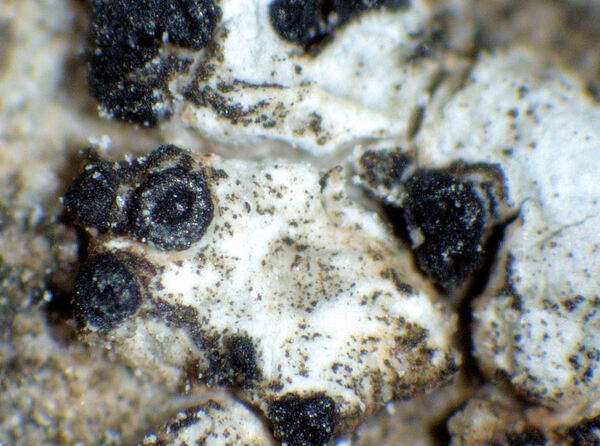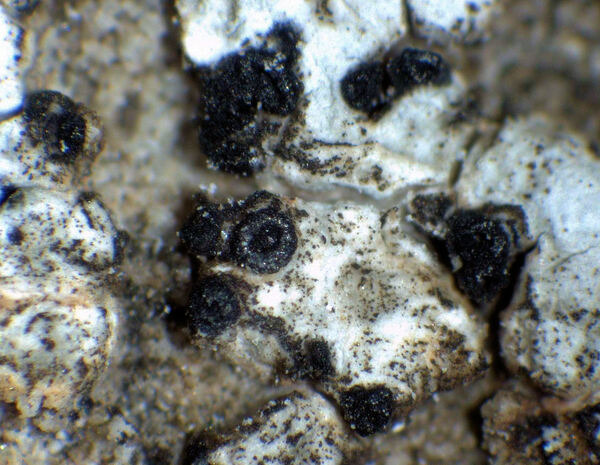Kiliasia episema (Nyl.) Hafellner
Beih. Nova Hedwigia, 79: 265, 1984.. Basionym: Lecidea episema Nyl. - Bot. Not.: 161, 1853.
Synonyms: Biatorina episema (Nyl.) A.L. Sm.; Bilimbia episema (Nyl.) Arnold; Catillaria athallina f. parasitica Bagl.?; Catillaria episema (Nyl.) H. Olivier; Catillaria supernula (Nyl.) H. Olivier; Lecidea supernula Nyl.; Scutula episema (Nyl.) Zopf; Toninia episema (Nyl.) Timdal
Distribution: N - VG, Frl (Brackel 2016), Lomb (Brackel 2016, Gheza & al. 2023), Piem (Isocrono & al. 2004, Brackel 2016), Emil (Brackel 2016), Lig (Hafellner 2006, Brackel 2016). C - Tosc (Hafellner 2006, Brackel 2016), Marc (Nimis & Tretiach 1999, Brackel 2016), Umb (Genovesi & Ravera 2001, Ravera & al. 2006, Brackel 2016), Laz (Brackel 2016), Abr (Nimis & Tretiach 1999, Brackel 2016), Mol (Nimis & Tretiach 1999, Caporale & al. 2008, Brackel 2016), Sar (Brackel 2016). S - Camp (Aprile & al. 2003b, Nimis & Tretiach 2004, Garofalo & al. 2010, Brackel 2016), Pugl (Nimis & Tretiach 1999, Brackel 2016), Bas (Hafellner 2006, Brackel 2016), Cal (Puntillo 1996, Brackel & Puntillo 2016, Brackel 2016), Si (Nimis & al. 1994, Brackel 2008b, 2016).
Description: Thallus not lichenized, the hyphae growing inside the thalli of calcicolous Circinaria-species. Apothecia lecideine, 0.2-0.6 mm across, often grouped and confluent, black, usually epruinose, with a flat to slightly convex disc and a thin, finally sometimes excluded proper margin. Proper exciple brownish black, usually with a green tinge, K+ intensifying green, N+ purple-red, lacking crystals; epithecium dark green, K+ intensifying green, N+ violet with the formation of blue crystals; hymenium colourless, 35-40(-50) µm high; paraphyses simple, not coherent, 1.7-2 μm thick, the apical cells swollen, up to 5 μm wide; hypothecium reddish brown, K+ purple, N+ orange-red. Asci 8-spored, clavate, surrounded by a gelatinous I+ blue coat, with a well-developed I+ blue tholus with a I+ darker blue tube and a well-developed ocular chamber, Bacidia-type. Ascospores 1-septate, hyaline, ellipsoid, (9-)10-14 x 3.5-4.5(-5.5) µm. Photobiont absent. Spot tests: thallus K-, C-, KC-, P-. Chemistry: probably without lichen substances.
Note: a mainly Mediterranean(-Atlantic) lichenicolous fungus found on hard limestone, on the thalli of Circinaria calcarea, more rarely of C. coronata and Protoparmeliopsis versicolor.
Growth form: Lichenicolous fungus
Substrata: rocks
Reproductive strategy: mainly sexual
paras Circinaria calcarea
Commonnes-rarity: (info)
Alpine belt: absent
Subalpine belt: absent
Oromediterranean belt: absent
Montane belt: rather rare
Submediterranean belt: common
Padanian area: extremely rare
Humid submediterranean belt: common
Humid mediterranean belt: rather common
Dry mediterranean belt: rare

Predictive model
Herbarium samples
Growth form: Lichenicolous fungus
Substrata: rocks
Reproductive strategy: mainly sexual
paras Circinaria calcarea
Commonnes-rarity: (info)
Alpine belt: absent
Subalpine belt: absent
Oromediterranean belt: absent
Montane belt: rather rare
Submediterranean belt: common
Padanian area: extremely rare
Humid submediterranean belt: common
Humid mediterranean belt: rather common
Dry mediterranean belt: rare

Predictive model
| Herbarium samples |
 INDEX FUNGORUM
INDEX FUNGORUM
 GBIF
GBIF
 DOLICHENS
DOLICHENS





